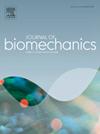赤足行走和慢跑对腓肠肌内外侧肌电活动的影响。
IF 2.4
3区 医学
Q3 BIOPHYSICS
引用次数: 0
摘要
腓肠肌无力与跟腱病和肌肉拉伤有关,内侧腓肠肌(MG)比外侧腓肠肌(LG)更容易受伤。步行和慢跑在日常活动和体育运动中很常见,而穿鞋运动和赤足运动之间的生物力学差异可能会影响内侧腓肠肌和外侧腓肠肌的激活。了解这些激活模式有助于优化预防损伤和/或康复的训练计划。该研究旨在比较步行和慢跑(穿鞋和赤足)过程中肌肉群和肌肉群肌电活动。29 名参与者(25.28 ± 4.53 岁,171.31 ± 0.76 厘米,72.68 ± 6.36 千克)在完成热身运动后,在两种条件下(赤足和穿鞋,随机顺序)分别进行了 1 分钟的步行(80-99 步/分钟)和慢跑(130-150 步/分钟)。肌电信号由可穿戴设备(mDurance Solutions S.L.,西班牙格拉纳达;1024 Hz 采样率)记录。我们测量了整个跨步周期的均方根(RMS)振幅,并对信号进行了数字滤波。为了进行分析,我们将肌电值归一化为两次冲刺中获得的平均峰值。我们采用重复测量方差分析来分析差异。我们观察到条件(赤脚-穿鞋)和腓肠肌(MG-LG)的显著影响(所有 p ≤ 0.023,ƞp2 = 0.17-0.39),赤脚条件下 MG 的激活程度高于 LG(p = 0.004-0.027,d = 0.72-0.83),而穿鞋条件下肌肉之间的差异不显著(p > 0.05)。与赤脚相比,穿鞋运动导致 MG 激活度降低(p = 0.001-0.003, d = 0.62-0.63 ),LG 激活度差异不显著。这些结果表明,与穿鞋的情况相比,赤足行走和慢跑会增加肌肉群的激活,而肌肉群的激活没有差异。此外,鞋类减少了中枢神经和后视神经之间的差异。本文章由计算机程序翻译,如有差异,请以英文原文为准。
Barefoot vs shod walking and jogging on the electromyographic activity of the medial and lateral gastrocnemius
Gastrocnemius weakness is associated with Achilles tendinopathies and muscle strains, with the medial gastrocnemius (MG) more commonly injured than the lateral gastrocnemius (LG). Walking and jogging are common in daily activities and sports, and biomechanical differences between shod and barefoot exercise may influence MG and LG activation. Understanding these activation patterns could help optimize training programs for injury prevention and/or rehabilitation. The aim was to compare MG and LG electromyographic activity during walking and jogging, both shod and barefoot. Twenty-nine participants (25.28 ± 4.53 years, 171.31 ± 0.76 cm, 72.68 ± 6.36 kg) completed a warm-up followed by 1 min of walking (80–99 steps/min) and jogging (130–150 steps/min) in both conditions (barefoot and shod, random order). Electromyographic signals were recorded using wearable devices (mDurance Solutions S.L., Granada, Spain; 1024 Hz sampling rate). We measured the root-mean-square (RMS) amplitudes for an entire stride cycle and digitally filtered the signals. For analysis, we normalized electromyographic values to the average peak values obtained during two sprints. We analyzed differences with a repeated-measures analysis of variance. Significant effects of condition (barefoot-shod) and gastrocnemius (MG-LG) were observed (all p ≤ 0.023, ƞp2 = 0.17–0.39), with higher MG activation compared to LG in the barefoot conditions (p = 0.004–0.027, d = 0.72–0.83), and nonsignificant differences between muscles in the shod conditions (p > 0.05). Shod exercise compared to barefoot resulted in lower MG activation (p = 0.001–0.003, d = 0.62–0.63) and non-significant differences in LG activation. These results indicate that barefoot walking and jogging increase MG activation compared to shod conditions, with no differences in LG activation. Additionally, footwear reduces differences between MG and LG.
求助全文
通过发布文献求助,成功后即可免费获取论文全文。
去求助
来源期刊

Journal of biomechanics
生物-工程:生物医学
CiteScore
5.10
自引率
4.20%
发文量
345
审稿时长
1 months
期刊介绍:
The Journal of Biomechanics publishes reports of original and substantial findings using the principles of mechanics to explore biological problems. Analytical, as well as experimental papers may be submitted, and the journal accepts original articles, surveys and perspective articles (usually by Editorial invitation only), book reviews and letters to the Editor. The criteria for acceptance of manuscripts include excellence, novelty, significance, clarity, conciseness and interest to the readership.
Papers published in the journal may cover a wide range of topics in biomechanics, including, but not limited to:
-Fundamental Topics - Biomechanics of the musculoskeletal, cardiovascular, and respiratory systems, mechanics of hard and soft tissues, biofluid mechanics, mechanics of prostheses and implant-tissue interfaces, mechanics of cells.
-Cardiovascular and Respiratory Biomechanics - Mechanics of blood-flow, air-flow, mechanics of the soft tissues, flow-tissue or flow-prosthesis interactions.
-Cell Biomechanics - Biomechanic analyses of cells, membranes and sub-cellular structures; the relationship of the mechanical environment to cell and tissue response.
-Dental Biomechanics - Design and analysis of dental tissues and prostheses, mechanics of chewing.
-Functional Tissue Engineering - The role of biomechanical factors in engineered tissue replacements and regenerative medicine.
-Injury Biomechanics - Mechanics of impact and trauma, dynamics of man-machine interaction.
-Molecular Biomechanics - Mechanical analyses of biomolecules.
-Orthopedic Biomechanics - Mechanics of fracture and fracture fixation, mechanics of implants and implant fixation, mechanics of bones and joints, wear of natural and artificial joints.
-Rehabilitation Biomechanics - Analyses of gait, mechanics of prosthetics and orthotics.
-Sports Biomechanics - Mechanical analyses of sports performance.
 求助内容:
求助内容: 应助结果提醒方式:
应助结果提醒方式:


